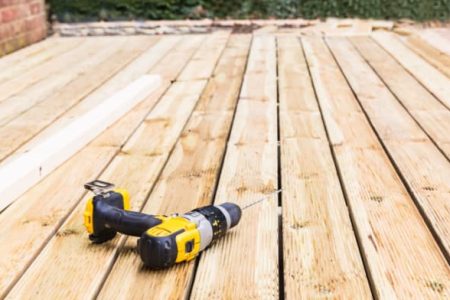
We’re now well into winter, which means you’re probably not spending so much time relaxing on your decking as you are spending time making sure it remains in good condition. One of the major winter maintenance jobs for timber decking or composite decking over the chillier months is to ensure that it remains safe, as chances are you or your family may still find yourselves walking over it every now and again. Decking that isn’t looked after can end up getting slippery very quickly – so here’s how to ensure that doesn’t happen!
This doesn’t have to be a particularly complex job in itself – all you have to do is sweep it occasionally. Crucially, you’ll want to keep it free of standing water for example, and you’ll definitely want to keep it free of any fallen leaves, twigs or fungus. Not only can they make your decking look untidy, but wet leaves in particular can be a major slipping hazard. Thankfully, they’re not too tricky to deal with!
These are two elements you’ll want to keep a particular eye out for, especially since they’re both notorious slipping hazards. One good way to spot them is by looking out for green spots or streaks in your decking that aren’t present elsewhere. Pick your cleaner carefully though, as you’ll need to make sure they’re suited to the surface you’re using them on. You won’t want to solve one problem (removing moss) by creating another in the form of marks on your decking.
One of the reasons it’s so important to remove standing water, as we mentioned above, is that it has a tendency to harden and form into ice, which is incredibly dangerous. The first instinct might be to crack it with a shovel, but that (or any metal tools) runs a serious risk of causing damage to your decking. Even composite doesn’t stand up well to direct impacts with a shovel. You’ll need to be similarly cautious of using salt. Certain types of grit may be less risky to use, provided they’re lightly brushed off after the ice has melted. In most cases, it’s best to use warm water to clear off the ice, and then sweep away any standing puddles afterwards.
While your decking can manage perfectly well throughout the winter as long as you stay on top of all the related maintenance tasks, you can save yourself some time and effort with non-slip decking oil, which contains compressed particles to create a rougher non-slip surface. It generally won’t crack or peel, and it can be easy to replenish where necessary. However it is a bit of an investment, so you may need to make a judgement call as to which you’d prefer – saving the money and simply making sure you keep on top of maintenance, or spending a bit extra on specialist decking oil, and getting a bit of time back. The choice is up to you!
And of course, if any of your boards do become damaged for whatever reason, you can always get replacements for the very best prices right here at Savoy Timber. From composite decking kits to timber boards, fixings and beyond, we have everything you need to create a stunning deck you can enjoy for years. You can shop our ranges online or visit one of our stores in Blackpool, Wigan, or Preston. If you have any questions give our friendly team a call on 0345 0268 799, we’re always happy to help!